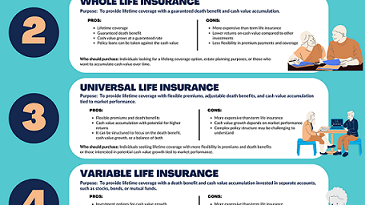Get the Right Insurance Coverage for You
Get the Right Insurance Coverage for You
Importance of Insurance Coverage
Insurance coverage serves as a fundamental pillar of financial security, protecting individuals and families from unforeseen expenditures that can arise from accidents, health crises, or property damage. By understanding the nuances of various insurance products, individuals can make informed choices that align closely with their unique circumstances and needs. For instance, life insurance options like whole, universal, and term insurance each provide distinct benefits and drawbacks, making it crucial for consumers to evaluate these differences carefully. This evaluation is depicted in the informative infographic , which outlines key attributes and considerations associated with each type of life insurance. Ultimately, appropriate insurance coverage not only safeguards against financial distress but also fosters long-term stability, underscoring the necessity of responsible planning and informed decision-making in one’s financial strategy.

II. Types of Insurance Coverage Available
When considering the types of insurance coverage available, a comprehensive understanding is essential for making informed decisions tailored to individual needs. Various insurance policies cater to different circumstances, including health, life, auto, and homeowners insurance, each with unique features and coverage options. For instance, health insurance plans play a pivotal role in ensuring access to medical care, covering routine check-ups and emergency services, while life insurance provides financial support to beneficiaries in case of the policyholders untimely death. A detailed exploration of life insurance reveals choices such as Whole Life, Universal Life, and Term Life, each designed to address specific financial planning goals illustrating the diversity of options available to consumers . Furthermore, parents face distinct challenges in enrolling their children in Medicaid and CHIP, highlighting the complexity of selecting appropriate health coverage (Orfield C et al.), (Barbara A Ormond et al.). Understanding these dynamics is crucial for optimizing insurance coverage.
III. Assessing Your Personal Insurance Needs
A thorough assessment of personal insurance needs is crucial in ensuring adequate financial protection against unforeseen circumstances. Individuals must evaluate their unique situations, including income, dependents, and health status, to determine the appropriate types and levels of coverage required. For instance, leveraging innovations such as consumer-driven health plans can optimize health-related insurance choices, as highlighted in the findings of (Bonnie J Austin et al.). Furthermore, understanding the specific quality deficiencies in health care, particularly for vulnerable populations like elderly Medicare beneficiaries, underscores the importance of tailored coverage, as discussed in (McCarthy D et al.). Through these considerations, individuals can choose suitable policies that not only meet immediate needs but also provide long-term security. In addition to health insurance, it may be wise to explore options for life insurance, as illustrated in , to safeguard the financial well-being of loved ones in the event of unexpected loss.
IV. Tips for Choosing the Right Insurance Provider
When seeking the right insurance provider, critical assessments of policy offerings and provider reliability are crucial. Start by narrowing down options based on the types of coverage needed, whether it is health, life, or property insurance. Each provider presents varied plans; thus, comparing the details of these plans, such as premiums, deductibles, and coverage limits, is essential to ensure alignment with personal or family needs. Additionally, verifying the providers reputation through customer reviews and industry ratings can offer insights into their service quality and claims process. An informative resource that can help in understanding the nuances of life insurance options—including whole, universal, and term life—is captured in . Furthermore, considering how providers support patient health literacy, especially in navigating coverage complexities, can enhance the decision-making process, as emphasized by the goals outlined in (Mavreles et al.). Therefore, thorough research will lead to informed choices, ensuring adequate coverage and peace of mind.
securing the right insurance coverage is an essential step toward safeguarding one’s financial future and well-being. This process involves a thorough evaluation of personal needs, financial situations, and the various types of insurance available, such as life, health, and property insurance. A relevant resource, exemplified by the infographic , effectively outlines the distinctions between various life insurance options, showcasing their unique benefits and drawbacks. By understanding these differences, individuals can make informed choices that best suit their circumstances and those of their dependents. Ultimately, the right insurance not only provides peace of mind but also acts as a crucial safety net in times of unforeseen challenges. Engaging with reliable resources and expert opinions will further empower individuals in this decision-making process, ensuring they select coverage that aligns with their specific requirements and aspirations for a secure future.



